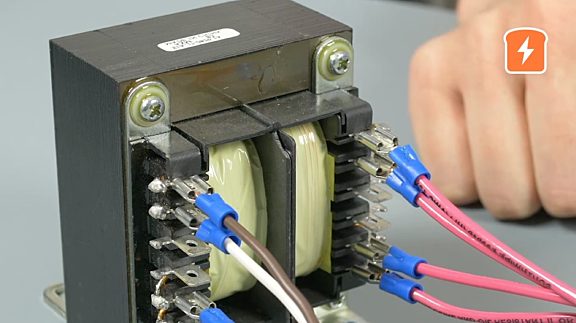Center-Tapped Full-Wave Rectifier Operation
Published
In our previous discussion about rectifiers, we discussed full-wave rectifiers and how they are different from half-wave rectifiers. We also discussed one type of full-wave rectifier, the bridge full-wave rectifier and learned how it operates to rectify both positive and negative half-cycles of the AC input. In this tutorial, we will proceed to the second type of full-wave rectifier, the center-tapped full-wave rectifier and discuss how it operates.

The reason why this type of full-wave rectifier is called a center-tapped rectifier is because it uses a center-tapped transformer. If you noticed in the schematic diagrams that we showed in the half-wave and bridge full-wave rectifier tutorials, you can see that the transformer has only a single winding on the secondary side. So if we want to create a power supply that uses a half-wave or bridge full-wave rectifier, we just use transformers that only have a single winding on the secondary side.


Transformers may have different numbers of windings on their primary and secondary sides. Some transformers only have a single winding on their primary and secondary sides but most of the transformers I’ve encountered have multiple windings on both sides. For example, the Triad Magnetics VPS24-5400 that we used in other tutorials, it uses dual winding on both sides and can be configured to have a series or parallel configuration. If you’re interested to learn how to wire transformers, you can check our tutorial here.

As you can see in the datasheet for the VPS24-5400, for a center-tapped transformer, this type of transformer is designed to produce two secondary voltages with a common connection at the center of the secondary winding. So the two voltages are the same and they can also provide the same power. From one end to the center tap, the voltage is obviously half of the total secondary voltage.


In figure 4, you can see how a center-tapped transformer is connected to a center-tapped full-wave rectifier. One of the differences between center-tapped and bridge rectifier is the numbers of diodes used to rectify both positive and negative half-cycles of the AC input. A bridge rectifier uses 4 diodes while a center-tapped rectifier uses only 2 diodes.

Triad Magnetics VPS24-5400
VPS24-5400 Power Transformer is a reliable and efficient transformer designed to handle high-voltage power applications. With a voltage rating of 4000VAC and power capacity of 130VA, this transformer can deliver a consistent and stable power supply.
FROM OnlineComponents.com
Center-Tapped Full-Wave Rectifier Operation
Now let’s discuss how a center-tapped full-wave rectifier operates. You can see in figure 5 the polarities on the secondary winding of a center-tapped transformer during the positive half-cycle of the AC input. In this case, D1 is forward-biased while D2 is reverse-biased. So the current flows through D1 and enters the load, then returns to the transformer through the center-tap connection as you can see in figure 5.

When the AC input switches to the negative half-cycle, the polarities on the secondary winding of the center-tapped transformer are reversed, as you can see in figure 6. So this time D1 is reverse-biased and D2 is forward-biased. The current flows through D2 and enters into the load in the same direction as it entered during the positive half-cycle of the AC input, then returns to the transformer through the center-tap connection. Since the current entered the load in the same direction in both positive and negative half cycles, the voltage across the load is a full-wave rectified DC voltage. But it’s still a pulsating DC which needs to be filtered before using as a DC power supply.

Average Value
The same with the bridge full-wave rectifier, the average value of a full-wave rectified voltage can be determined by this equation:

Peak Output Voltage

The peak output voltage of a center-tapped full-wave rectifier is only equal to the half of the transformer secondary voltage minus the forward voltage of the diode. If you’re going to check the current flow during the positive and negative half-cycle of the AC input, you will notice the load only sees half of the transformer secondary voltage and not the total secondary voltage. So to determine the peak output voltage across the load, check what is half of the transformer secondary voltage and use this equation:

Peak Inverse Voltage

Now for the peak inverse voltage (PIV) of the diodes in a center-tapped full-wave rectifier, let’s assume that the AC input is in the positive half-cycle (see figure 8). So D1 conducts with a 0.7V diode drop while D2 is reverse-biased. By using Kirchhoff’s voltage law we get this equation,

Rearranging the equation, we get the PIV equation:

The PIV that D2 (or D1 during negative half-cycle) must withstand while in reverse-bias condition is equal to the secondary voltage of the center-tapped transformer minus one diode drop which we assume equal to 0.7V.
Summary
In this tutorial, we’ve discussed center-tapped full-wave rectifiers and their operation. We’ve also discussed briefly how a center-tapped transformer is designed. I hope you’ve found this tutorial interesting or helpful. We're grateful for the support of our Friend of CircuitBread, Triad Magnetics! You can learn more about other transformers and magnetics at triadmagnetics.com that they offer for your practical projects. If you have any questions, leave it in the comments below. See you in our next tutorial!
Further Reading & Related Content

Get the latest tools and tutorials, fresh from the toaster.







